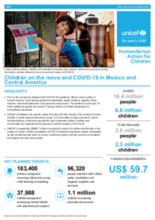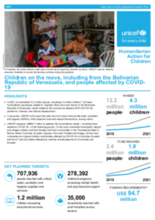Displaying 161 - 170 of 835
Using survey data collected in 2010 from Ghanaian school children, this study investigates variations in children’s durable goods and private utilities when parents migrate internally or internationally compared to a control group of children who live with their parents.
This edition of Humanitarian Action for Children – UNICEF’s annual humanitarian fundraising appeal – describes the ongoing crises affecting children on the move and COVID-19 in Mexico and Central America (including unaccompanied and separated children); the strategies that UNICEF is using to respond to these situations; and the donor support that is essential in this response.
This edition of Humanitarian Action for Children – UNICEF’s annual humanitarian fundraising appeal – describes the ongoing crises affecting children on the move, including from the Bolivarian Republic of Venezuela, and people affected by COVID-19; the strategies that UNICEF is using to respond to these situations; and the donor support that is essential in this response.
In this World Bank Blog Post, Saskia Blume and Nour Moussa of UNICEF's Children on the Move Team describe how "millions of ‘children left behind’ are taking the brunt of this fallout as their family members who moved internally or abroad in hopes of sustaining them, cut down on remittances" as a result of the COVID-19 pandemic.
A cross-sectional study was conducted in five counties of five provinces in China to investigate the effects of age at separation and duration of maternal separation on the early development of left-behind children.
Informed by developmental perspectives that consider young people's development through participation across contexts in everyday life and by research into how parents in ‘ordinary’ families organize care, the authors of this article developed a study based on interviews with 15 unaccompanied refugee minors and their professional caregivers at residential care institutions.
This webinar heard from three of Family for Every Child's member organisations about their programmes to both integrate and reintegrate children on the move.
Using survey data consisting of 5002 eighth graders from 160 middle schools in northwestern China, this paper investigates how parental migration affects children’s non-cognitive abilities, as is measured by Big Five components of conscientiousness, extraversion, neuroticism, agreeableness, and openness, as well as children’s grit.
The current study investigated the effects of parental emotional neglect on left-behind children’s externalizing problem behaviors, the mediating role of deviant peer affiliation, and the moderating role of beliefs about adversity in the association between parental emotional neglect and left-behind children’s externalizing problem behaviors.
This article proposes a methodological workflow for data analysis by machine learning techniques that have the possibility to be widely applied in social issues.


